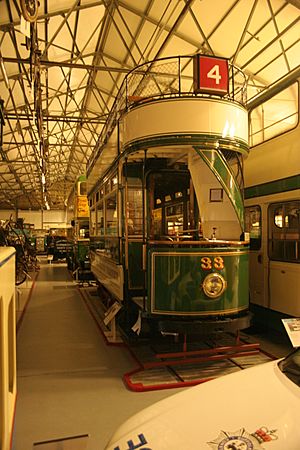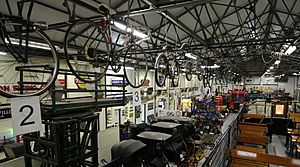Ipswich Transport Museum facts for kids
The Ipswich Transport Museum is a cool place in Ipswich, Suffolk, England. It's all about the history of transport and amazing machines. Everything you see here was either made or used in the local area.
The museum's collection started way back in 1965. A group called the Ipswich Transport Preservation Group began gathering old vehicles. In 1988, they got their current home. It's an old depot where trolleybuses used to be kept. The museum first opened its doors to visitors in 1995.
The museum has over 100 large items! These include buses, trams, and buses from local companies. You can also see commercial vehicles, fire engines, mobile cranes, bicycles, and even horse-drawn vehicles. There are also prams and wheelchairs. Many items are from famous Ipswich manufacturers like Ransomes, Sims & Jefferies and Ransomes & Rapier. The museum also has many electric vehicles.
You can learn about local trains and boats too. There are also exhibits about aviation. These are mostly shown through photos and smaller displays. The museum also has a huge collection of old documents, books, costumes, and tickets.
The museum is a registered charity. This means it's a non-profit group that helps the community. It's usually open on Sundays from April to November. During school holidays, it's also open on weekday afternoons. The museum often holds special events. One big event is the annual Ipswich to Felixstowe Run. This is a parade of old vehicles that happens every May. They drive from Christchurch Park in Ipswich to the Promenade in Felixstowe.
Contents
Discover the Collection
The museum's collection began 50 years ago with just one bus. Today, it has grown into a huge and varied display of objects. You can explore trams, trolleybuses, and motorbuses. There are also lorries, fire engines, and horse-drawn vehicles. Don't miss the bicycles, prams, ambulances, and even a police car! The collection also includes a funeral hearse. Many smaller items, displays, and old papers support the main exhibits.
The museum also features the Ipswich Engineering Collection. This part shows many items from well-known local companies. These include Ransomes, Sims and Jefferies, Ransomes and Rapier, Cranes, Reavell, and Cocksedge. You can see cranes, forklift trucks, lawnmowers, and farm equipment.
The museum's team works hard to bring old vehicles back to life. Around 2018, they finished restoring a Co-op horse-drawn bread van. Other projects included a 1939 Dennis Ace bus and a 1965 Scammell Scarab mechanical horse. After these, the team started on a Co-op battery-electric coal truck. This truck was made by Morrison-Electricar. They received a £7,000 grant in 2018. This money helped them restore the truck to working order. They fixed the motor and controls and bought new batteries.
A Cambridge horse tram was also fully restored in 2019. This tram had a long history! It was built in 1880 for Bath Tramways. Later, it was used by the Bradford and Shelf Tramway. It was even pulled by steam tram locomotives! Eventually, it moved to the Cambridge Street Tramways in 1894. When that system closed in 1914, the tram was sold. It ended up being used as a shed.
The tram was found again in 1988. Its lower deck was being used as a cobbler's workshop in Ely. The museum saved it from being torn down. A seven-year restoration project began in 2012. As they worked, they found clues about its past. Markings showed it had been in Bradford. Handwriting confirmed it was originally built for Bath. The restoration got a big boost from a £49,000 grant. This came from the Heritage Lottery Fund. The tram was built with one deck, but an upper deck was added later. Recreating this upper deck was very difficult. The tram now looks just like Cambridge Street Tramways No. 7.
Early Vehicles (Before 1930)
- Starbuck horse tram: This tram was built in 1880 for the Cambridge Street Tramways.
- Brush tramcar: This is Ipswich Corporation Tramways No. 33. It's a double-deck tram with an open top, built in 1904.
- Ransomes electric dustcart: This 1915 vehicle was first tested by Birmingham city council. It was later used by Ransomes as a work vehicle until the 1960s.
- Railless trolleybus: Ipswich Corporation No. 2 was built in 1923. It was used as a caravan after 1934. The museum got it in 1977.
- Ransomes, Sims & Jefferies type D trolleybus: Ipswich Corporation No. 9 was built in 1926. It was rebuilt in the 1930s.
- Ransomes, Sims & Jefferies type D trolleybus: Ipswich Corporation No. 16, also from 1926. Only its chassis remains today.
- Richard Garrett & Sons type O trolleybus: Ipswich Corporation No. 26 was built in 1926. It was used as a summerhouse after 1945.
- Tilling-Stevens B9B bus: Eastern Counties Roadcar Company No. 78 was built in 1927.
1930s Vehicles
- Chevrolet LQ coach: This vehicle was built in 1930.
- Bedford WLB bus: This bus was built in 1932.
- Ransomes, Sims & Jefferies trolleybus: Ipswich Corporation No. 46 was built in 1933. It was one of the first double-deck trolleybuses for Ipswich.
- Dennis Ace bus: This Eastern Counties bus was built in 1938.
- Leyland Cub Fire Engine: This fire engine was built in 1938.
- Bristol L5G bus: This Eastern Counties bus was built in 1939.
- Dennis New World Fire Engine: This fire engine was built in 1939.
1940s Vehicles
- Ransomes MG Crawler tractor: This tractor was built in 1947.
- AEC Monarch tower wagon: Ipswich Corporation used this vehicle, built in 1948.
- Karrier W trolleybus: Ipswich Corporation No. 105 was built in 1948. It was fully restored and working again by 2014.
- Smith Electric Vehicles / Northern Coach Builders electric milk float: Ipswich Co-op E56D was built in 1948. It replaced horse-drawn delivery services.
- Bedford OB: This vehicle was built in 1949.
- Bristol K6B bus: This Eastern Counties bus was built in 1949.
- Bristol L4G bus: This Eastern Counties bus was built in 1949.
- Land Rover fire engine: This fire engine was built in 1949.
1950s Vehicles
- AEC Regent III bus: Ipswich Corporation Transport No. 1 was built in 1950.
- Bristol LS bus: This Eastern Counties bus was built in 1950.
- Commer Avenger Fire Appliance: This fire appliance was built in 1950.
- Sunbeam F4 trolleybus: Ipswich Corporation No. 126 was built in 1950. It was later used in Walsall.
- Atkinson 8-wheel lorry: This large lorry was built in 1950.
- Morrison-Electrical coal lorry: Ipswich Co-op E92C was built in 1951. It delivered coal until 1983.
- AEC Regal IV bus: Ipswich Corporation Transport No. 9 was built in 1953.
- AEC Regent III bus: Ipswich Corporation Transport No. 16 was built in 1954.
- Ford E83W pickup: This pickup truck was built in 1954.
- Mercury Truck and Tractor Co timber tractor unit: This unit was built in 1954. It was used for hauling timber in the dock area.
- Dennis F12 P/E fire engine: This fire engine was built in 1954.
1960s Vehicles
- Bristol HA6G articulated lorry: This lorry was built in 1962.
- Bedford J emergency vehicle: This vehicle was built in 1962.
- AEC Regent V bus: Ipswich Corporation Transport No. 63 was built in 1964.
- Bristol MW bus: This Eastern Counties bus was built in 1964.
- Bristol LFS bus: This Eastern Counties bus was built in 1965.
- Scammell Scarab 3-wheel tractor unit: This unique tractor unit was built in 1965.
- Smith electric vegetable cart: Ipswich Co-op FDX 346D was built in 1965. It delivered vegetables door-to-door.
- AEC Regent V bus: Ipswich Corporation Transport No. 68 was built in 1966.
- Brush Pony electric van: This van was built in 1967 for St Helens Hospital. It was used as a laundry van.
Later Vehicles (1970s onwards)
- Commer Maxiload TS3 lorry: This lorry was built in 1970.
- AEC Swift bus: Ipswich Corporation Transport No. 82 was built in 1971.
- Karrier Bantam lorry: This lorry was built in 1974.
- Scania Super 110 lorry: This lorry was built in 1974.
- Leyland Atlantean AN68 bus: Ipswich Corporation Transport No. 6 was built in 1976.
- Leyland National bus: This Eastern Counties bus was built in 1978.
- Ford Transit Ambulance: This ambulance was built in 1984.
- Leyland Sherpa K2-250 electric van: Ipswich Buses used this experimental electric van, built in 1985.
- Land Rover fire tender: This fire tender was built in the 1980s. It was used at Ipswich Airport.
- Optare Spectra bodied DAF DB250 bus: This bus was built in 2000 for Ipswich Buses.
- Vauxhall Omega police car: This police car was built in 2000.
- Renault Master ambulance: This ambulance was built in 2000.
See also
- Trolleybuses in Ipswich



